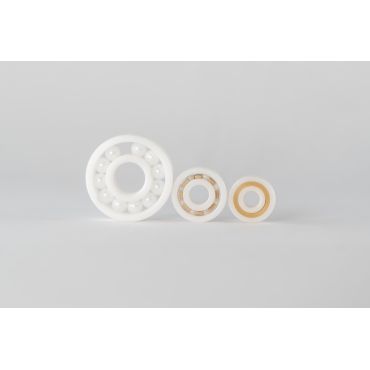
Ceramic bearings in zirconia for shaft sizes from 0.125" up to 1.0"
See product table below for dimensions and technical drawings
See Products Variants below for silicon nitride options
ZrO2 or zirconium dioxide is a tough ceramic material with very similar expansion properties to steel. This is an advantage when considering shaft and housing fits for higher temperature applications. Although we usually refer to these bearings as ZrO2 bearings, they are made from ZrO2 stabilised with yttrium oxide which gives the material added strength and increased fracture resistance at room temperature. This is sometimes known as YSZ or YTZP. ZrO2 bearings are roughly 70% of the weight of steel bearings.
Zirconium dioxide bearings have high hardness, very smooth wear surfaces and can run without lubrication so they are frequently used where very low turning resistance is important. They have a very low coefficient of friction compared to steel bearings or even hybrid bearings. The coefficient of friction for ZrO2 bearings at ambient temperature in air with a light load is approximately 0.0012.
The inch-sized ZrO2 full ceramic ball bearings listed below are available with cages (or retainers) made from PEEK or PTFE. Bearings with bore sizes from 8mm upwards can also be fitted with 316 stainless steel cages. In addition, we keep stock of full complement ZrO2 bearings. These have no cage and extra balls. For full complement type, the load ratings are approximately 20% higher but the maximum speed is up to 70% lower. As for bearing cages, PEEK is generally the preferred option from stock due to the strength and durability of PEEK. If an alternative cage material is required to cope with particular chemicals or temperature extremes beyond the range of PEEK, these can be manufactured to order. Inch-sized ZrO2 bearings are not magnetic and they are highly corrosion resistant to most chemicals. They are also extremely water resistant which is why they are often used in marine applications, particularly where the equipment is fully submerged or where 316 marine grade bearings will not cope with the load or speed. It is important to note that if ZrO2 has prolonged contact with steam or hot water, there may be some weakening of the material over time.
Full complement ZrO2 imperial bearings or those with a 316 stainless cage can be used up to 600°C. The maximum speed should be decreased as the temperature increases above ambient, particularly if the bearings are unlubricated. Bearings with a PEEK cage are rated up to 250°C due to the lower maximum temperature of the cage material. It may be preferable to use a looser radial play at high temperatures, particularly if the inner ring temperature is likely to be greater than the outer ring temperature as this will reduce the radial play of the bearing. Our ZrO2 imperial bearings are supplied with a looser C3 radial play as standard.
Although PEEK is very durable, it will become more brittle at low temperatures so it is worth considering PTFE or 316 stainless steel cages for temperatures below -70°C. For an overview of the pros and cons of using ZrO2 bearings, you can click HERE to see a helpful guide on selecting ceramic bearings.
Most of the range of inch sized ZrO2 ceramic bearings are supplied from stock in the UK. We also supply full ceramic imperial bearings from stock in silicon nitride. See Products Variants below for the Si3N4 versions.
Click on INFO in the rows below to display technical drawings of the bearings with load and speed data. Please note that the maximum loads and speeds are used in theoretical life calculations. It is recommended to use bearings at significantly less than the maximum load and speed ratings to ensure reasonable bearing life. ZrO2 full ceramic bearings are best used at low speeds. For higher speeds or continuous rotation over long periods, they will perform better with Si3N4 balls. For further information contact sales@smbbearings.com.

